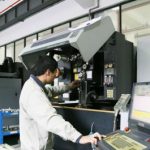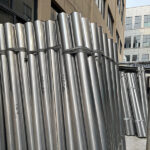A lot of people may wonder why insulated water bottles can keep drinks hot or cold for long hours, here is an introduction of the manufacturing process of vacuum insulated water bottles, which can help you to understand the question.
Raw Materials
The primary raw materials used in the manufacture of the insulated water bottle are stainless steel, which forms the outer cup and the inner cup of the bottle.
The Manufacturing Process
1. The stainless steel arrives at the factory in the form of stainless steel pipes or stainless steel sheets.
2. The stainless steel is made into two bottle shapes, one bigger than the other, and the bigger one becomes the outer bottle, while the smaller one becomes the inner bottle. There’re basically two different methods to make stainless steel to a bottle shape: Explosive Hydroforming and Deep Drawing.
Explosive Hydroforming: in this method, we use stainless steel pipes as material. First, a stainless steel pipe is cut at the appropriate length, and a large amount of water is injected into the pipe. The pipe then swell into a bottle shape under the huge pressure of the water. With this method, the bottle formed is with no bottom, so a round stainless steel plate will be welded onto it to form a complete bottle.
Deep Drawing: in this method, the stainless steel sheets are used as material. First, the stainless steel sheets are cut into round plates at appropriate size, and then we use a punch press which uses 660 tons of force to stretch the stainless steel plate into a cylinder with a bottom, and a bottle shape is formed.
The inner bottle and the outer bottle can be formed with either of these two methods.
3. A blade chops the opening of the bottles down to the correct size.
4. A tool/machine is used to squeeze the opening of the bottles to a bottle neck.
5. Then the inner and outer bottles are welded together to get ready for vacuum insulation. Once welded together, they’re thoroughly inspected to ensure everything is sealed seamlessly.
6. Once the vacuum insulation is created, the bottles undergo a temperature test, where hot air is blown into each bottle. If the outside of the bottle stays cool, that means the heat from the hot air is not transferred out, and the bottle is vacuum insulated. On the contrary, if the bottle becomes hot, there’s something wrong with the vacuum insulation, and that bottle will be pulled from the line.
7. After the temperature test, the bottles are sent into a wash station to get rid of the lubricating oil and dust from the forming process, and then dried thoroughly.
8. Next, the exterior of the bottle is polished carefully and cleaned.
9. After the polishing process, there’ll be a second temperature test.
10. Now the bottles are ready for exterior coating. Packshine has both spray painting and powder coating options.
11. The coated bottles are baked to dry the coating
12. After the coating is completed, designs and logos are printed onto the bottle via various techniques – silk screening, heat transfer, water transfer – to name a few.
13. Each bottle is inspected thoroughly, including a third time temperature test, appearance inspection, leakage tests etc. and then placed in individual bag for assembly.
The Lid
Unlike the bottle, the lid of the insulated water bottle is usually made from plastic, and they’re injection molded.
Sometimes, a bottle lid is plastic inside and wrapped by stainless steel on the outside. It’s made by pressing a sheet of stainless steel onto the injection molded plastic.
Packshine also has the all-stainless steel top option.
The stainless steel bottles and the lid are assembled, boxed and packed in cartons for shipment.


